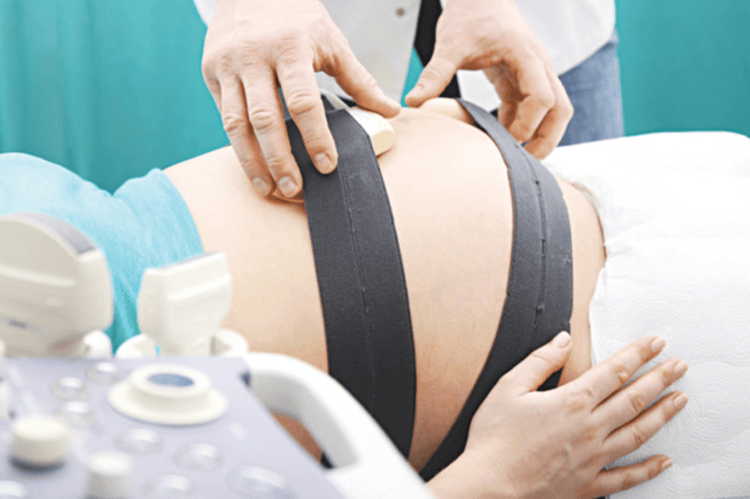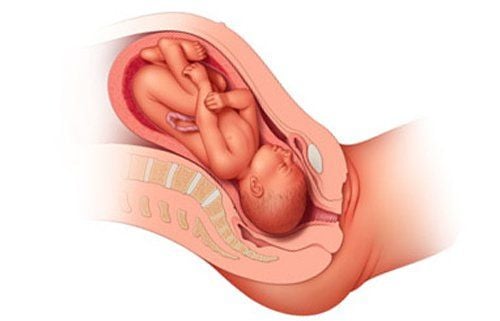This is an automatically translated article.
Translated and compiled by Dr. Kharitonchyk Aksana - Obstetrics and Gynecology Center - Vinmec Times City International Hospital
When gestational age ≥ 37 weeks, be prepared for labor. The following signs signal that you are indeed entering labor.
1. What are the real signs of labor?
Strong and regular uterine contractions: Uterine contractions are the driving force of labor:
Contracts usually start when you feel pain in your back, then move to the front of your abdomen and the pain spreads from bottom of the uterus. Uterine contractions appear regularly, periodically, gradually stronger, each contraction you feel your abdomen hard, the pain increases in each contraction. There are about 2 contractions in 10 minutes, the duration of uterine contractions is increasingly prolonged (> 25 seconds), for about 1-2 hours, then gradually increases in frequency and intensity. Vaginal discharge with blood:
Vaginal discharge is pink, brown or slightly bloody, do not be too worried because this is a sign of cervical dilation. If you have a lot of vaginal bleeding, bright red, you should go to the hospital right away even if you don't have much abdominal pain because it can be a danger sign for you and your baby. Your water breaks :
You can see water coming out of the vagina, it can be more or less, in this case, even if you don't have abdominal pain, you should go to the hospital right away.

Cervical dilation:
Labor contractions will help clear the cervix. When your contractions are regular and your doctor says your cervix has cleared and dilated ≥ 2 cm, you've really entered labor.
Other signs of labor:
Low back pain and cramps : You may feel an increasing discomfort or cramping in your pelvis and rectum, as well as a dull ache in your lower back. . Diarrhea or nausea: You may also have loose stools early in labor or start vomiting for no apparent reason.

2. Distinguish false and true uterine contractions
According to the American College of Obstetricians and Gynecologists, false labor contractions, also known as Braxton Hicks contractions, often appear in the third trimester of pregnancy, especially the last month of pregnancy before delivery.
False uterine contractions often occur at short irregular intervals and are spaced apart. False contractions are often felt in the front of the body in the lower abdomen when you walk or increase activity. These contractions you can feel but usually do not cause the feeling of cramping, Braxton Hicks contractions are usually weaker and may go away with rest or changing positions.
Real labor contractions happen when you have regular uterine contractions, 2 contractions in 10 minutes, increasing in frequency and intensity. Real labor contractions don't go away even when you change positions, or lie down at rest.
Trắc nghiệm: Vì sao mẹ sinh mổ xong khó có sữa ngay?
Vì sao mẹ sinh mổ xong khó có sữa ngay là thắc mắc và lo lắng chung của nhiều sản phụ. Bài trắc nghiệm này sẽ giúp sản phụ giải đáp thắc mắc cũng như tìm hiểu được phương pháp gọi sữa về sau sinh mổ.The following content is prepared under supervision of Thạc sĩ, Bác sĩ y khoa, Tạ Quốc Bản , Sản phụ khoa , Khoa Sản phụ khoa - Bệnh viện Đa khoa Quốc tế Vinmec Phú Quốc
3. What should pregnant women do when there is actual labor?
During active labor, uterine contractions will gradually increase in frequency and intensity. You will feel increasing pain, which makes you feel anxious and tired. What should you do? Follow the instructions of the doctors and midwives:
Relaxation, gentle movement, breathing exercises during pain to help regular contractions. Good air circulation helps the baby get enough oxygen and helps the cervix to progress well. Snacking during labor makes it easy to digest, and drinking enough water helps keep you hydrated and nutrient-dense so you have enough energy for labor. Listening to music, massaging the waist and shoulders by the closest person, especially your husband, will help you feel less pain and be greatly supported. You can get support from your pain doctor if you feel pain is taking a toll on your health and well-being with labor pain relief measures that make labor a wonderful experience. wonderful and you will be in good spirits as you await the birth of your baby.

4. Matters needing attention
Have bright red blood or vaginal discharge (not brown or pink) Your water breaks – especially if the amniotic fluid is green or brown. This can be a sign of meconium in the amniotic fluid (baby's first stool) and is dangerous if inhaled by the baby during birth. Blurred or double vision, severe headache, or sudden swelling. These can all be symptoms of preeclampsia, which is characterized by gestational high blood pressure and requires special medical attention. At Vinmec International General Hospital, there is a package maternity service as a solution to help pregnant women feel secure because of the companionship of the medical team throughout the pregnancy. When choosing Maternity Package, pregnant women can:
The pregnancy process is monitored by a team of qualified doctors Regular check-up, early detection of abnormalities Maternity package helps to facilitate the process. birthing process Newborns get comprehensive care

Please dial HOTLINE for more information or register for an appointment HERE. Download MyVinmec app to make appointments faster and to manage your bookings easily.
Reference source: livescience.com; aboutkidshealth.ca; mayoclinic.org














